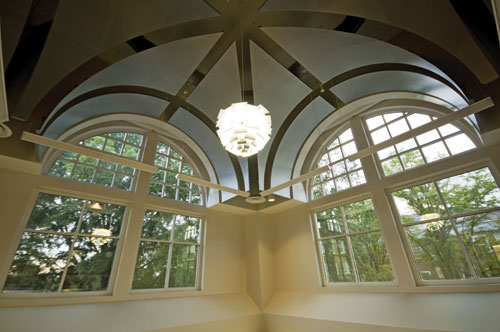Innovative Metal Solutions for the Built Environment
Metal Ceiling Systems
Along with metal ceiling finishes, manufacturers offer a variety of sizes and shapes where designers want the ceiling to express a module or make a statement. These designs can incorporate acoustical absorption. While a standard metal ceiling offers little acoustical value, perforating the panels and adding a backer material can typically provide acoustical absorption, or noise reduction coefficient (NRC) of .65. Adding fiberglass backing behind the ceiling typically provides an NRC of .90. Metal ceilings can provide increased security to a space where ceiling access must be discouraged or prevented. The security levels can be moderate for supervised spaces, or greater for unsupervised prison occupancies.
 |
A 20-foot-high suspended, segmented, vaulted custom ceiling system crowns the space at Winthrop University’s Vivian Moore Carroll Hall, in Rock Hill, South Carolina. Architect: FWA Group. Photo by Dustin Shores Photography, Charlotte, NC; courtesy of Chicago Metallic |
Linear Metal Ceilings
Developed in the 1960s to add additional design elements to spaces, linear metal ceilings feature continuous lines in various styles and finishes. Linear systems can be flat or curved by using different suspension methods, inside or outside.
Panels are nominally 4 inches wide or wider and available in round or square edges. Finishes can be painted, such as baked enamel, powder coat and metallic; plated, such as brass and chrome; or woodgrain, from paint, polymers and veneers.
The spaces between the panels may be left open for acoustical or air movement requirements, or closed with separate filler strips or integral filler strips. They can be used as an open plenum system, such as in large public waiting areas, or may be solid or perforated to add acoustical absorption.
Linear metal ceilings have been used extensively on exterior and interior applications. They allow designers options for visual design continuity from exterior outdoor vestibules, entryways, and soffits to interior spaces. Exterior ceilings are engineered for wind load bracing. Local codes determine the necessary degree of wind resistance. Linear metal ceilings can accommodate positive and negative pressures while integrating building services such as lighting, air diffusion, and audio accessories.
Metal Panel CeilingsLay-in metal panels are durable, available in different finishes, standard and custom sizes, can be perforated for acoustical absorption, and can have reveal edges. They can also be formed into pods or clouds for unique design elements. Perforation patterns typically include borders to prevent bending at a perforation.
Another variation, snap-up metal panels, offers tight joints, no visible grid, and provides security, to discourage or prevent unauthorized access to ceiling plenums. The snap-up system can be also perforated for acoustics and used in various configurations. Snap-up panel systems can be used in exterior applications, with proper bracing.
Design Issues
Building codes, acoustics, corrosion, and materials must be reviewed when specifying metal ceilings.
Codes include fire, seismic, and wind load requirements:
- Fire ratings: Metal ceilings are typically characterized by a Class A fire rating (ASTM E 84), but are not included in any UL time rated designs.
- Seismic: The International Building Codes addresses seismic restraints for ceiling suspension.
- Wind load: Exterior wind load requirements are dictated by local code officials, typically using UL: 580 and ASTM C636-04.
Acoustics: Solid metal panels without perforations offer no acoustical absorption. Perforated panels can offer acoustical absorption, expressed as the noise reduction coefficient. Perforated panels with a backer material typically yield a 65 NRC, while perforated panels with polybagged insulation can yield a 90 NRC.
Corrosion is a factor when considering materials. The site environment and cleaning regimen must be addressed when choosing base materials for these systems.
Materials: Steel is only suitable for interior use and must be painted or clear coated to reduce corrosion. Recycled content will always be minimum 25 percent. Aluminum is suitable for interior and exterior use. Painted aluminum panels contain almost 100 percent recycled material. Aluminum panels that are anodized must be made from 100 percent bauxite, or aluminum ore. This includes brass and chrome coat finishes.









